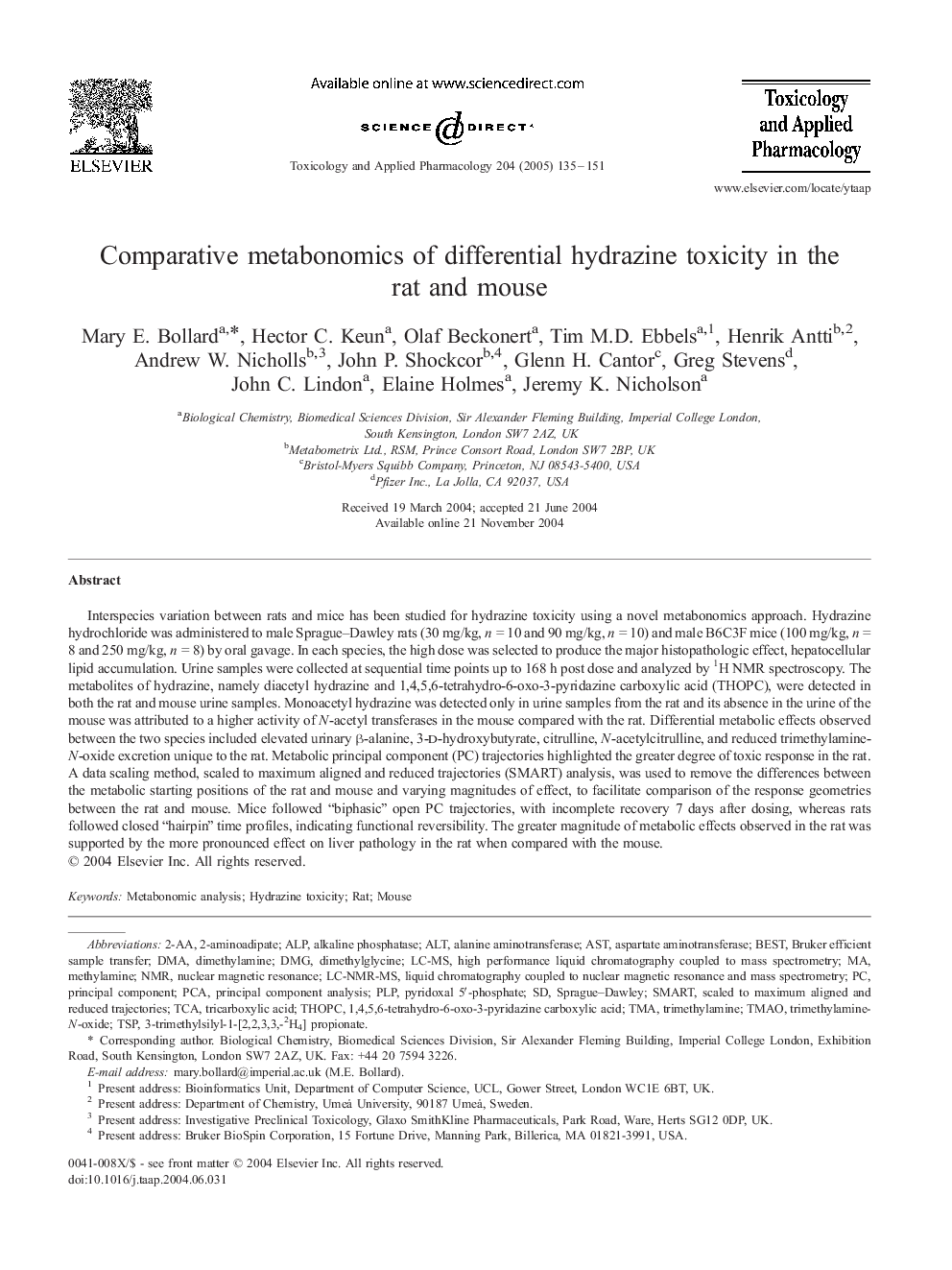| کد مقاله | کد نشریه | سال انتشار | مقاله انگلیسی | نسخه تمام متن |
|---|---|---|---|---|
| 9018166 | 1128691 | 2005 | 17 صفحه PDF | دانلود رایگان |
عنوان انگلیسی مقاله ISI
Comparative metabonomics of differential hydrazine toxicity in the rat and mouse
دانلود مقاله + سفارش ترجمه
دانلود مقاله ISI انگلیسی
رایگان برای ایرانیان
کلمات کلیدی
PLPDMATMATCATSPALTLC-MSDmgTMAOnuclear magnetic resonance - رزونانس مغناطیسی هستهای2-AA - 2 AAPCA - PCAAST - آسپارتات ترانس آمینازAspartate aminotransferase - آسپارتات ترانس آمیناز یا AST Alanine aminotransferase - آلانین آمینوترانسفرازALP - آلکالن فسفاتازAlkaline phosphatase - آلکالین فسفاتاز یا فسفاتاز قلیاییSprague–Dawley - اسپراگ داولیtricarboxylic acid - اسید تری کربوکسیلیکBEST - بهترینPrincipal component analysis - تحلیل مولفههای اصلی یا PCAtrimethylamine - ترتی الیامینTrimethylamine-n-oxide - تریمتییلامین-n-اکسیدNMR - تشدید مغناطیسی هستهای dimethylglycine - دی متیل گلیسینDimethylamine - دی متیلامینMethylamine - متیلامینMouse - موشRat - موش صحراییprincipal component - مولفه های اصلیSMART - هوشمندانهpyridoxal 5′-phosphate - پیریدوکسال 5'-فسفات
موضوعات مرتبط
علوم زیستی و بیوفناوری
علوم محیط زیست
بهداشت، سم شناسی و جهش زایی
پیش نمایش صفحه اول مقاله

چکیده انگلیسی
Interspecies variation between rats and mice has been studied for hydrazine toxicity using a novel metabonomics approach. Hydrazine hydrochloride was administered to male Sprague-Dawley rats (30 mg/kg, n = 10 and 90 mg/kg, n = 10) and male B6C3F mice (100 mg/kg, n = 8 and 250 mg/kg, n = 8) by oral gavage. In each species, the high dose was selected to produce the major histopathologic effect, hepatocellular lipid accumulation. Urine samples were collected at sequential time points up to 168 h post dose and analyzed by 1H NMR spectroscopy. The metabolites of hydrazine, namely diacetyl hydrazine and 1,4,5,6-tetrahydro-6-oxo-3-pyridazine carboxylic acid (THOPC), were detected in both the rat and mouse urine samples. Monoacetyl hydrazine was detected only in urine samples from the rat and its absence in the urine of the mouse was attributed to a higher activity of N-acetyl transferases in the mouse compared with the rat. Differential metabolic effects observed between the two species included elevated urinary β-alanine, 3-d-hydroxybutyrate, citrulline, N-acetylcitrulline, and reduced trimethylamine-N-oxide excretion unique to the rat. Metabolic principal component (PC) trajectories highlighted the greater degree of toxic response in the rat. A data scaling method, scaled to maximum aligned and reduced trajectories (SMART) analysis, was used to remove the differences between the metabolic starting positions of the rat and mouse and varying magnitudes of effect, to facilitate comparison of the response geometries between the rat and mouse. Mice followed “biphasic” open PC trajectories, with incomplete recovery 7 days after dosing, whereas rats followed closed “hairpin” time profiles, indicating functional reversibility. The greater magnitude of metabolic effects observed in the rat was supported by the more pronounced effect on liver pathology in the rat when compared with the mouse.
ناشر
Database: Elsevier - ScienceDirect (ساینس دایرکت)
Journal: Toxicology and Applied Pharmacology - Volume 204, Issue 2, 15 April 2005, Pages 135-151
Journal: Toxicology and Applied Pharmacology - Volume 204, Issue 2, 15 April 2005, Pages 135-151
نویسندگان
Mary E. Bollard, Hector C. Keun, Olaf Beckonert, Tim M.D. Ebbels, Henrik Antti, Andrew W. Nicholls, John P. Shockcor, Glenn H. Cantor, Greg Stevens, John C. Lindon, Elaine Holmes, Jeremy K. Nicholson,